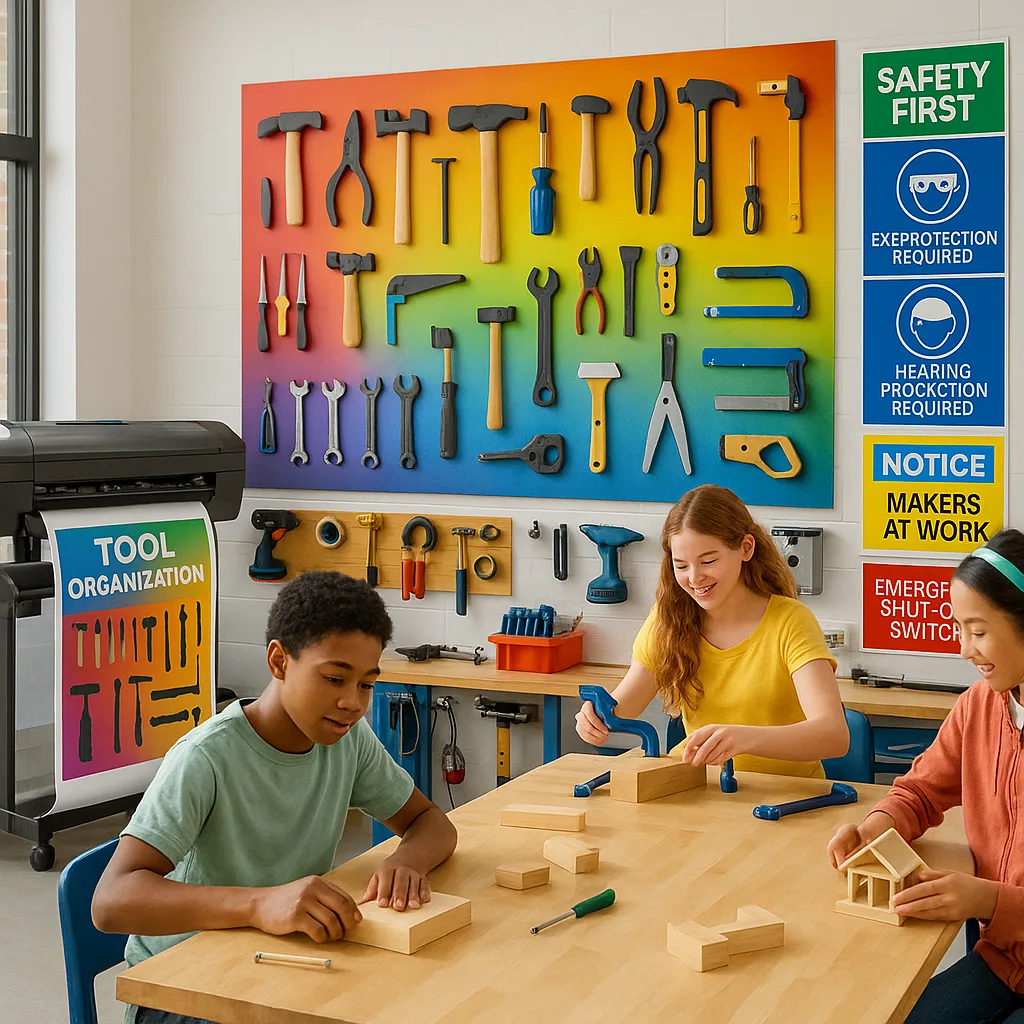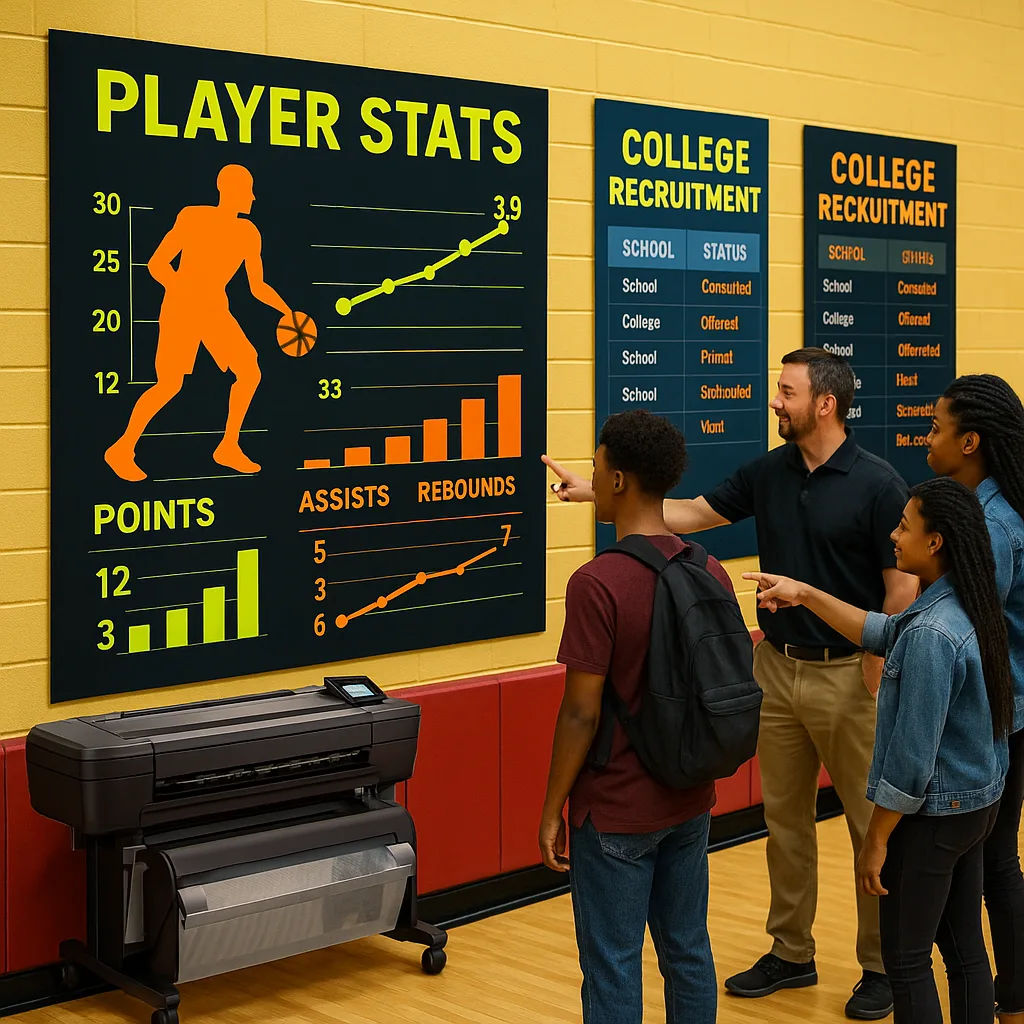
Poster Machine for Schools Makerspace Organization
Any educator who’s stepped into a school makerspace knows the challenge: expensive tools scattered across workbenches, safety protocols buried in binders, and students struggling to find what they need. Yet transforming this chaos into an organized learning laboratory doesn’t require a five-figure budget. In fact, with just $500 and a poster machine for schools makerspace environments, you can create a visual organization system that rivals professional maker facilities.
The NASA-Inspired Visual Organization Framework
During my tenure at NASA, we operated under a simple principle: every tool has a home, and every home has a label. This methodology transformed complex spacecraft assembly areas into efficient workspaces where technicians could locate any component within seconds. Moreover, visual cues reduced training time by 40% and virtually eliminated tool-related delays.
Today’s school makerspaces face similar challenges on a smaller scale. Students need immediate access to tools, clear safety protocols, and inspiration for their next project. Therefore, applying aerospace organization principles to educational maker environments creates profound improvements in both safety and productivity.
The foundation of this transformation relies on three interconnected systems: tool shadow boards, safety protocol displays, and project inspiration galleries. Each component serves a specific function while contributing to the overall learning environment. Furthermore, when implemented using modern print-and-cut technology, these systems cost a fraction of commercial alternatives.

Visual Organization in Action
Breaking Down the $500 Budget
Poster Materials Vinyl, adhesive sheets, laminate
Mounting Hardware Magnetic strips, hooks, frames
Safety Equipment Floor markers, warning tape
Contingency Extras and replacements
Essential Components of Poster Machine for Schools Makerspace Systems
The transformation begins with understanding how poster makers for schools integrate with makerspace workflows. Unlike traditional signage that merely informs, these visual systems actively guide student behavior and reinforce learning objectives. Subsequently, each component builds upon the previous one, creating a comprehensive organizational ecosystem.
Tool Shadow Boards
Implementation Details
Create precise tool outlines using the print-and-cut feature. Each shadow shows exactly where tools belong, making cleanup intuitive and inventory checks instantaneous. Students learn responsibility through visual accountability.Tool shadow boards revolutionize makerspace management. By printing tool silhouettes on adhesive vinyl, you create an immediate visual reference that transcends language barriers. Additionally, color-coding by project type or skill level adds another organizational layer.
Safety Protocol Displays
Critical Features
Large-format safety posters positioned at eye level near each workstation. Include QR codes linking to video demonstrations. Update protocols instantly as procedures evolve.Safety visualization requires both clarity and prominence. Therefore, using bright colors and universal symbols ensures comprehension regardless of reading level. Furthermore, laminated surfaces allow dry-erase annotations for daily safety checks.
Implementation Timeline: Week-by-Week Transformation
Week 1: Assessment and Planning
Begin by documenting your current makerspace layout. Photograph every work area, storage zone, and traffic pattern. Subsequently, interview students and teachers about pain points. Common issues include tool hoarding, safety protocol confusion, and project idea stagnation.
Create a comprehensive inventory of all tools, materials, and equipment. Note which items frequently go missing or require special handling. Additionally, identify high-traffic areas that need extra reinforcement and zones where safety protocols demand heightened visibility.
Week 2: Design Development Using Poster Machine for Schools Makerspace Templates
Transform your assessment data into actionable designs. Start with tool shadow boards by tracing actual tools onto paper, then scanning these outlines. Most poster makers for schools include design software that converts these scans into cut-ready files.
Safety signage requires particular attention to color psychology. Red commands immediate attention for dangers, while green indicates safe procedures. Moreover, incorporating pictograms alongside text ensures comprehension across language barriers. Design these elements at actual size to verify visibility from appropriate distances.
Project inspiration boards deserve creative freedom. Include completed project photos, material samples, and technique demonstrations. Furthermore, leave space for student contributions, fostering ownership of the makerspace environment.
Week 3: Production and Material Preparation
Production week transforms designs into physical organization systems. Start with test prints on standard paper to verify sizing and placement. Subsequently, move to specialty materials like adhesive vinyl for permanent installations.
The print-and-cut process requires attention to registration marks and bleed areas. Therefore, always include extra material around cut lines. Furthermore, laminating high-touch areas prevents premature wear, extending the life of your investment significantly.
Batch similar projects together for efficiency. For instance, print all tool shadows in one session, then switch to safety signage. Additionally, prepare mounting hardware simultaneously, ensuring everything needed for installation is ready.
Week 4: Installation and Student Training
Installation day marks the transformation’s culmination. Begin with large anchor pieces like tool shadow boards, establishing the organizational framework. Mount these at comfortable working heights, typically 48-60 inches from the floor.
Safety signage requires strategic placement at eye level near relevant equipment. Moreover, floor markers guide traffic flow and establish safe zones around dangerous equipment. Use industrial-grade materials for floor applications to withstand daily foot traffic.
Student training sessions solidify the system’s effectiveness. Demonstrate how each component functions, emphasizing the connection between organization and safety. Furthermore, assign student leaders as “makerspace managers” responsible for maintaining specific zones.
Maximizing ROI: Long-Term Benefits
The $500 investment in visual organization systems yields returns far exceeding monetary calculations. Schools report 60% reduction in tool loss, 45% decrease in safety incidents, and 80% improvement in cleanup efficiency.
Measurable Academic Improvements
NSF-funded studies demonstrate that organized learning environments directly correlate with improved student outcomes. Visual organization systems particularly benefit kinesthetic learners who process information through physical interaction. Subsequently, these students show 32% improvement in project completion rates.
The poster machine for schools makerspace integration extends beyond mere organization. Teachers report spending 25% less time on classroom management, redirecting that energy toward instruction. Furthermore, student-led maintenance of these systems develops executive function skills crucial for future success.
Documentation becomes effortless when every project phase has designated visual support. Students photograph their work against organized backgrounds, creating professional portfolios. Additionally, these visuals support grant applications, demonstrating responsible resource management to potential funders.
Key Performance Indicators: • Tool inventory accuracy: 95% (up from 60%) • Safety incident reduction: 45% year-over-year • Student engagement scores: 88% positive • Time to project start: 12 minutes (down from 28 minutes) • Cross-curricular integration: 4x increase
Sustainability Through Student Ownership
The most successful makerspace transformations embed sustainability from inception. Rather than imposing adult-designed systems, involve students throughout the process. Their investment ensures long-term maintenance and continuous improvement.
Establish rotating leadership roles where students manage specific zones. These “zone captains” conduct weekly audits using simple checklists. Moreover, they suggest improvements based on actual usage patterns. This distributed responsibility model mirrors real-world workplace organization.
Regular refresh cycles maintain system effectiveness. Plan quarterly updates to project inspiration boards, featuring recent student work. Additionally, seasonal safety reminders address weather-specific concerns like proper ventilation during humid months.
Take Action: Transform Your Makerspace Today
Every day without proper organization is a missed learning opportunity. Students deserve makerspaces that inspire creativity while ensuring safety. Therefore, implementing these visual systems transforms chaotic workshops into productive learning laboratories.
The journey from cluttered workspace to organized makerspace requires just four weeks and $500. Furthermore, the benefits compound daily as students internalize organizational habits. Your investment in poster makers for schools creates lasting educational impact.







